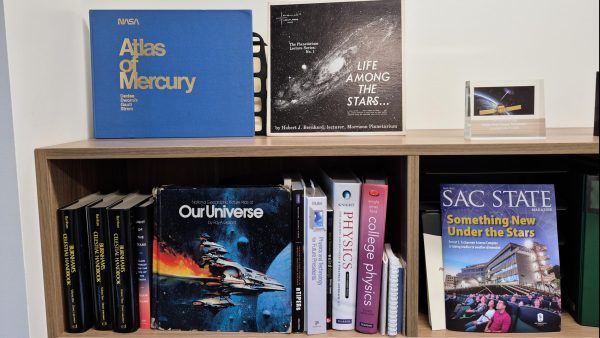For thousands of years, the night sky has been one of humanity’s greatest mysteries and a prevalent source of curiosity. Even today, as scientists shoot countless satellites, telescopes and space stations out of the atmosphere and into Earth’s orbit, we struggle to comprehend exactly what is happening in our universe.
“One of the things that is the hardest for people to wrap their head around is just how big and empty space is,” Kyle Watters, a physics and astronomy professor at Sacramento State, said. “As big as planets and stars and galaxies are, they are dwarfed by the vast, empty distances of nothing between them.”
Watters has been Sac State’s planetarium coordinator for over seven years and made it his mission to convey the scale and beauty of the cosmos while inspiring students in the same way he was from a young age.
Watters said he remembers his passionate third grade teacher Mr. Kraemer and an astronomy book titled “Our Universe” as early influences in his passion for astronomy.
“When there was free time in that class, I would go and grab that book,” Watters said. “And around seven years ago, when the planetarium opened, Mr. Kraemer came to Sac State – the grand opening – and he gave me the book.”
Eventually, Watters also developed an interest in physics, earning his Ph.D. at Stanford University in 2010. He has been teaching physics ever since and has been a professor at Sac State since 2014.

Since its opening in 2019, the planetarium has been utilized as a powerhouse for curiosity. In addition to supporting the astronomy program, it often hosts engaging shows that are open to the general public and serves as a frequent field trip destination for K-12 students.
According to Watters, he and his colleagues welcome around 20,000 school-aged children in a given year for field trips alone.
“In a typical semester, I think we usually do somewhere between 150 and 200 field trips,” Watters said. “One of the things that we have done as a university, as part of our educational service to our community, is that we don’t charge for field trips.”
He says that many school teachers have brought their students and expressed their gratitude for this educational accessibility. Some teachers note that their schools wouldn’t have been able to afford the trip otherwise.
The planetarium offers an immersive experience unlike any other classroom. A high-tech laser projector emits a 360-degree view that can mimic a night sky flooded with celestial bodies.
RELATED: Have an astro-nomical day at Sac State’s planetarium with these shows
“It does seem even easier to get my students excited,” Watters said. “I would show a big slide of a picture of Saturn or something. And now I can fly us through the solar system to Saturn, and we can orbit around Saturn on this amazing 2,500 square foot dome screen.”
In larger cities, it can be easy to forget the jaw-dropping mysteries that are right above us every night. Light pollution makes most stars impossible for many Americans to see.
“It’s a little bit of a bummer, yeah,” Watters said of the lack of visibility. “But in some ways, that makes it even more impressive when they come to the planetarium and I can show them, because in the planetarium, there is no light pollution.”
Planetarium shows are held monthly, and the next public programs are set for Oct. 24-26. The presentations will feature a few new additions to the program, including “JWST Year Three,” “Aurora: Lights of Wonder” and “Backyard Astronomy.”
“JWST Year Three” will give the audience a detailed look at recent photos taken by the most powerful telescope humans have ever built: the James Webb Space Telescope.
“July of 2025 was the three-year anniversary of [JWST] data releases,” Watters said. “So we’ve built a new show with all of the new stuff from the most recent year; [the planetarium will show] some amazing photographs, still images and a couple really cool videos from NASA.”

Tickets to the planetarium can be purchased at the Hornet ticket office. Tickets are free to Sac State students and children under 12 and are only $5 for the general public.
Watters hopes the planetarium can effectively reignite people’s curiosity for astronomy and get them more involved in the space community.
”My goal when I teach is to inspire just a little bit of that curiosity,” Watters said. “If they’re not going to become astronomers, at least I want to turn them into someone who checks the NASA website once a month to see what they’re doing.”
For young people who are unsure of what to pursue in life, Watters offers some consolation and recommends they take an introductory astronomy course in the planetarium.
”It is absolutely OK to arrive at college undeclared.” Watters said. “Take a couple classes, a couple different things and see what really inspires you. What ignites you? What’s your passion? What do you get excited about? And if you can study that and make a career out of that, go for it.”
Watters uses himself as an example.
”I love my job,” Watters said. “I love talking about space. I love teaching people about physics and about astronomy and about the universe we live in. So yeah, it makes a huge difference in life.”
Kathryn is the main contributor to the quiz section of LaDailyGazette.com. If you have an idea for a quiz, let us know.





